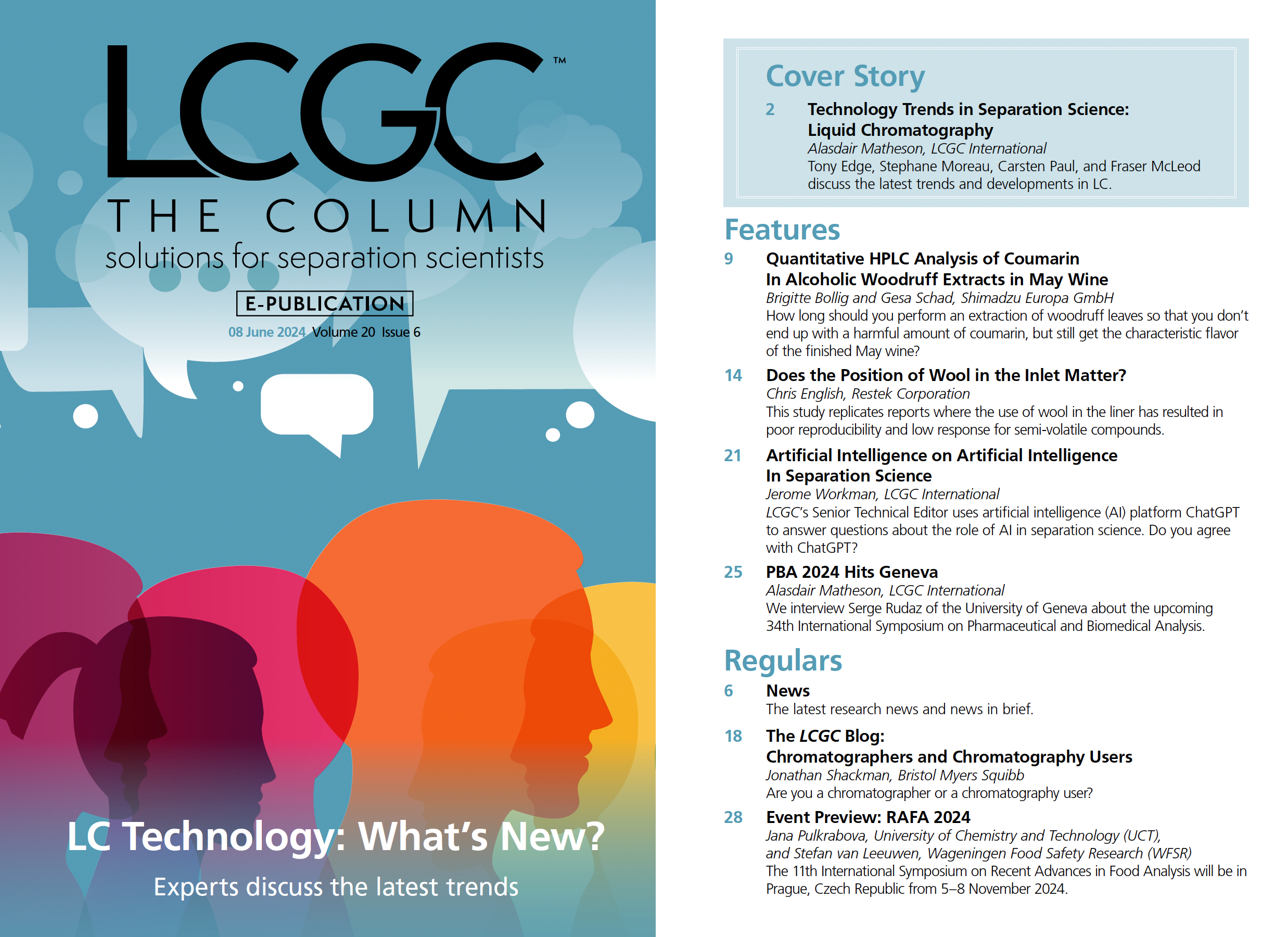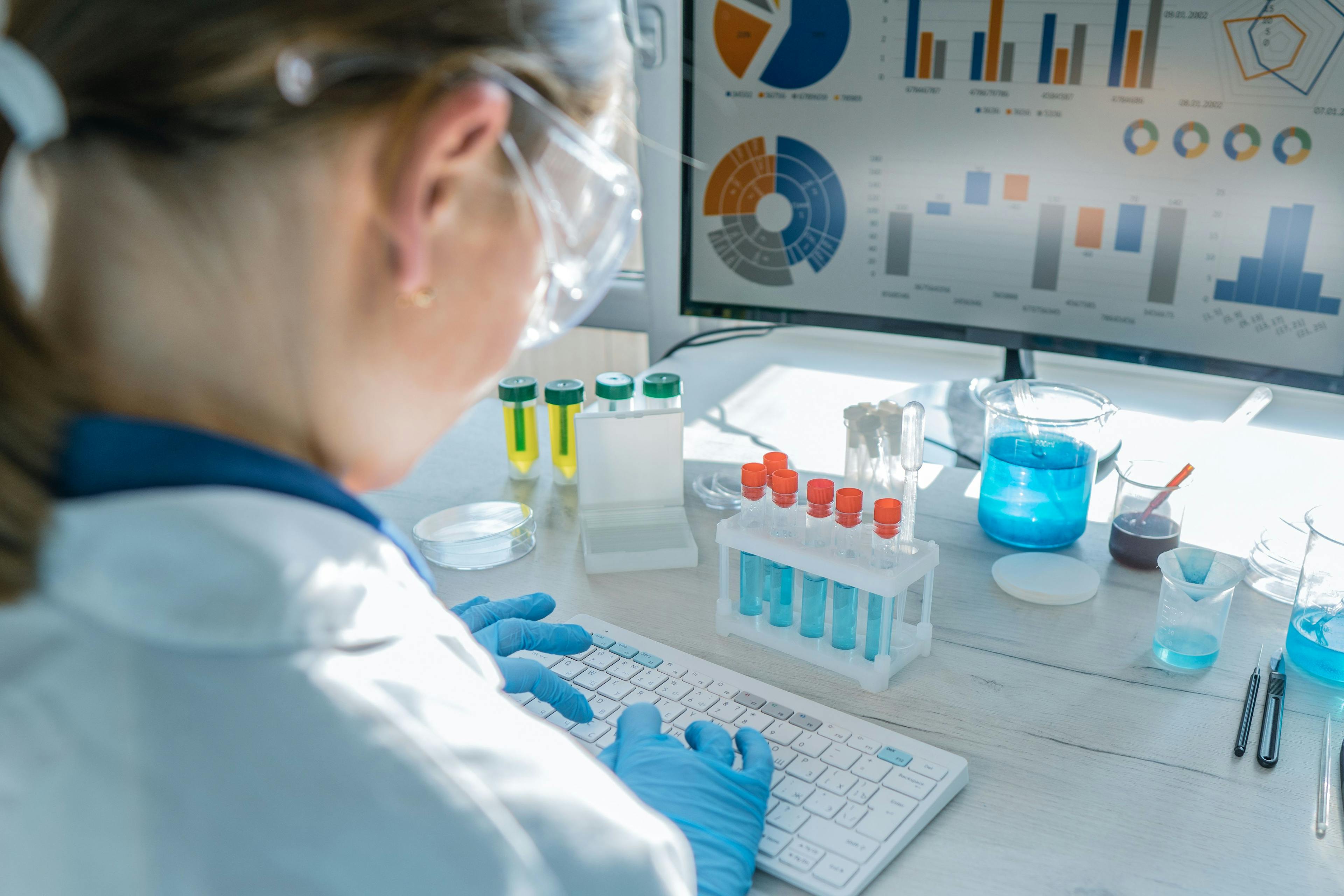Technology Trends in Separation Science: Liquid Chromatography
Tony Edge, R&D Leader at Avantor, Stephane Moreau, Manager LC–MS & LifeSciences at Shimadzu Europa GmbH, Carsten Paul, Senior Staff Product Manager of LC Systems at Thermo Fisher Scientific, and Fraser McLeod, Vice President of QA/QC and Wyatt Technology at Waters Corporation, discuss the latest trends and developments in liquid chromatography (LC).
What trends do you see emerging in LC or LC–mass spectrometry (MS)?
EDGE: We are seeing a growing use of the technology in fields that previously would not have used LC–MS. More and more, LC–MS is seen as an underpinning technology that allows for the determination of the molecular constituents of a sample at very low levels. This presents many opportunities but also many challenges as more non-specialists become LC–MS users. It also means that the technology will start to move into the mainstream, with the wider general population starting to come into contact with sampling devices that are shipped to LC–MS laboratories—and who knows, one day perhaps even have LC–MS instruments that we can hold in our hands.
MOREAU: After a decade where improvements on instruments have drastically sped up the possibilities on the hardware side—such as ultrahigh-pressure liquid chromatography (UHPLC) for fast chromatography, analytical intelligence to automate start-up and shut-down, fast polarity switching, fast scanning, and fast multiple reaction monitoring (MRM) acquisition on the MS side—the quantity of data generated in a shorter time is now putting pressure on analysts and software. The use of artificial intelligence (AI) for automatic integration and data processing is starting to reduce the burden on people for large batch analysis as well as reducing variability in data processing. The additional benefit of such tools is the ability to exploit the amount of data to anticipate deviation and future breakdown on systems. The other part is the automation of sample preparation. In the post-Covid era, the laboratories are struggling to hire workforces, and automation is the way to compensate for the lack of workforce.
PAUL: Overall, it seems that the race of all vendors to increase the performance of the UHPLC system, measured often in terms of column efficiency or maximal available system pressure, is over. High performance liquid chromatography (HPLC) is now only one of the many tools available in a laboratory, which emphasizes the need to provide logical and consistent user experience and mitigates the need for in-depth expertise in every piece of laboratory equipment. Examples include providing better instrument diagnostics or “at-instrument” guidance for common procedures such as exchanging wear parts. Lastly, automation of full workflows from sample preparation through data analysis has become a reality and offers benefits in terms of freeing up valuable analyst time and increasing result reproducibility.
MCLEOD: What we are seeing overall in the pharmaceutical industry is organizations trying to use information more efficiently across their pipeline, whether it be from a method life cycle perspective, instrument utilization, or cross-correlating data for molecule attributes. The overall theme is driving better efficiency to reduce costs. In quality control (QC), we are seeing an increased focus on tracking, trending, and eliminating causes for method failure.
In terms of modalities, new, more challenging molecules are in discovery and development, many of which are metal-sensitive. Without the use of instruments and column chemistries that have specific bio-inert surfaces, scientists have to contend with the frustration of having to passivate the equipment, redo analytical runs, or worse, miss peaks and signals that otherwise would be detectable with the right equipment.
What is the LC or LC–MS application area that you see growing the fastest?
EDGE: The area that has seen the greatest growth in recent years is the area of in situ measurements, although it is not the biggest area of use. This can be applied to a range of market sectors, including production lines, surgeries, environmental monitoring, homeland security, or even space exploration. The possible application areas of having mass spectrometers made smaller and simpler to use opens up whole new markets, and I see this as being the most exciting area of development. It will need appropriate extraction and chromatography systems to support the application of the LC–MS instrumentation, but advances in high-throughput LC and improvements in more robust solid-phase extraction (SPE) have suggested that there are more applications that will be done in this growing area.
MOREAU: Currently, the penetration of mass spectrometry, such as matrix-assisted laser desorption ionization (MALDI) and LC–MS in the field of clinical analysis, is at a turn with the implementation of the new In Vitro diagnostic (IVD) regulation. The systems are becoming more and more robust, and the number of applications is increasing in therapeutic drug monitoring, oncology, toxicology, and microbiology. The benefits of data given by LC–MS (selectivity, multiplexing, and precision) for the doctor’s decisions is recognized. However, this also requests from LC–MS suppliers to simplify workflows with automation in the sample preparation, laboratory automation system (LAS) connections, and standardization with ready-to-use clinical reagent kits. In the post-Covid era, the laboratories are struggling to hire workforces, and automation is the way to compensate for the lack of people and ensure continuity.
PAUL: The landscape of chemical medicines and biologic entities used for pharmaceutical development is constantly evolving. Over the last decade, we already saw a strong uptake on the development of protein-based therapeutics. Today, we see much more complex developments of biotherapeutics, such as antibody–drug conjugates (ADCs), bi- or tri-specific antibodies, or even complex mixtures of antibodies. In the last few years, we have also seen strong momentum for the development and commercialization of nucleotide-based therapeutics, including oligonucleotides and messenger ribonucleic acid (mRNA). Other nucleotide-based modalities, such as oligonucleotide conjugates or small interfering RNA, have also seen a strong uptake, signaling a future of therapies heavily leveraging biotherapeutics. The complexity of these types of medicines requires more sophisticated analytical tools for characterization and quality control, including increasing use of MS.
MCLEOD: From a modality perspective, there has been a shift to cell and gene therapy in the Americas and European Union (EU), and also with ADCs, particularly in China. Customers are also very much engaged in oligonucleotides and CRISPR-Cas 9 as the next “big” thing.
What obstacles stand in the way of LC or LC–MS development?
EDGE: The obstacles that I foresee in this area are trying to ensure that the technology does not become too accessible. As a greater number of users are engaged with the technology, there is a tendency for the manufacturers to dumb down the operation of the instrumentation, and this will lead ultimately to scientists reporting the data generated by the mass spectrometer without necessarily being aware whether the data makes sense. The technology is not yet robust enough to be widely spread amongst the non-analytical community without a degree of education.
MOREAU: With current trends towards further implementation of MS to accelerate and refine clinical decisions, several points must be improved without compromising existing benefits. For LC–MS, one of them is the variability from system to system and the perceived complexity of configurations. Compared to immunoassay analysers looking like “black boxes,” LC and LC–MS are looking complex despite the big improvements realized. The software workflow, the laboratory information system (LIS) connections, and the graphical user interface (GUI) will also help to adopt the technology and a better integration in each laboratory. LC–MS can not only contribute to improving diagnostics for patients, but it also helps laboratories to improve their workflow and return of investment by multiplexing analysis, reducing plastics waste, and reducing energy consumption.
PAUL: With a weaker economic outlook in 2024, it is more important than ever to ensure any new instrument technologies have the user in mind. Without this focus, customers will simply not be interested in stretching their budgets because of greater scrutiny to justify the investment.
New technologies, such as AI applications, might also be entering the field of HPLC, for instance, for data analysis or user support, even though the acceptance of users and regulatory agencies particularly in regulated environments is not fully defined.
Another aspect is the need for better data sharing and integration in a highly connected world between sites, platforms, and software packages. Here, industry standards are still lacking.
MCLEOD: Although the toolbox is growing, the molecules are more complex than traditional therapies, and to some extent, customers are still defining what attributes are important in terms of analysis. The challenges include developing the required techniques for separations and analysis quick enough to help our customers. As always, supporting our solutions with the informatics tools to analyze data efficiently and effectively is always a priority.
What was the biggest accomplishment or news in 2023- 2024 for LC or LC–MS?
EDGE: There have been no truly groundbreaking developments in the field of LC or LC–MS. However, small steps have been made to move the technology forward, particularly in the resolution and applicability of ion mobility to LC–MS. In the field of chromatography, the development of lithographic-based columns that do not use spherical particles has improved batch-to-batch robustness of columns, and it has also allowed the theoreticians the opportunity to develop new designs of flow paths through a column.
MOREAU: Lipidomics is a very important area of research with crucial implications in many areas such as health and diet, to name a few. But analyzing lipids remains a very complex topic because of the structure of these compounds. Recently, new technologies for fragmentation of ions have appeared in MS, which considerably simplify the interpretation of spectra and allow much easier differentiation between different structures. This will for sure give a boost to the lipidomics research with translation in future diagnostics.
PAUL: Low-flow HPLC, spanning from nano to capillary flow rates, historically needed a higher user expertise to operate such delicate systems. This has dramatically changed and now any HPLC user can run such an instrument and could potentially benefit from low-flow HPLC such as higher MS sensitivity, and low solvent and sample consumption. In combination with the newest developments in high-resolution accurate-mass analyzers, higher throughput, higher sensitivity, and deeper coverage is achievable in proteomics experiments.
Finally, it seems that nowadays USP 621 emphasises more than before the modernization of methods leading to higher throughput, higher sensitivity, and reduce environmental impact.
MCLEOD: We are seeing the value proposition of error reduction and ease of use is resonating with our customers, and we expect in 2024 a broader range of workflows focusing on this value proposition.
Tony Edge is R&D leader at Avantor.

Stephane Moreau is Manager LC–MS & LifeSciences at Shimadzu Europa GmbH.

Carsten Paul is Senior Staff Product Manager of LC Systems at Thermo Fisher Scientific.

Fraser McLeod is Vice President of QA/QC and Wyatt Technology at Waters Corporation.


New Study Reviews Chromatography Methods for Flavonoid Analysis
April 21st 2025Flavonoids are widely used metabolites that carry out various functions in different industries, such as food and cosmetics. Detecting, separating, and quantifying them in fruit species can be a complicated process.
University of Rouen-Normandy Scientists Explore Eco-Friendly Sampling Approach for GC-HRMS
April 17th 2025Root exudates—substances secreted by living plant roots—are challenging to sample, as they are typically extracted using artificial devices and can vary widely in both quantity and composition across plant species.


















